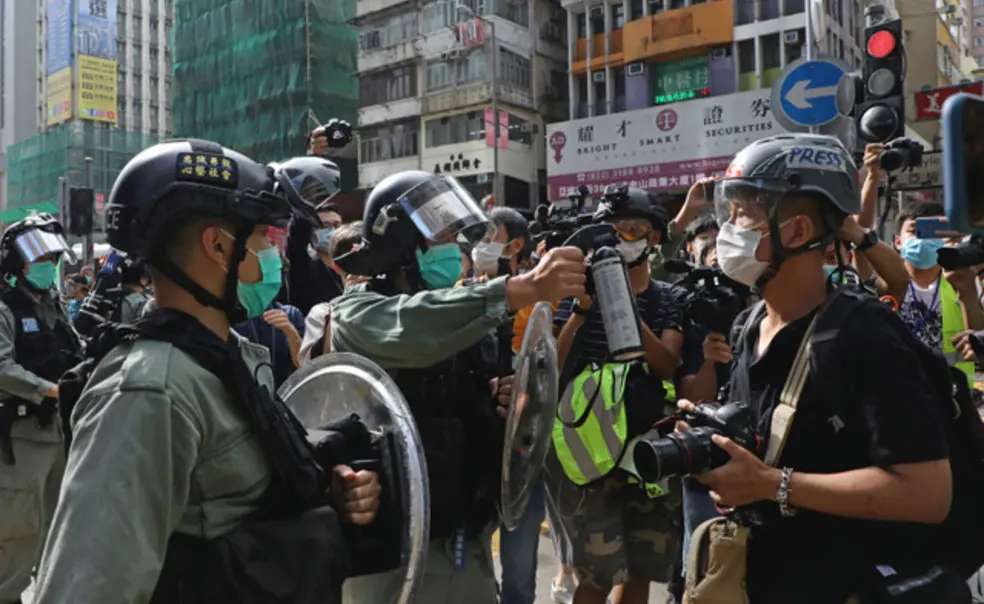Essay: Post-Pandemic, Hong Kong Protests Will Likely Return
“Resistance has continued, only in a different form,” writes journalist Mary Hui ’17
On the morning of June 12, 2019, I stepped out of Admiralty station of the Mass Transit Railway in Hong Kong at rush hour and saw that thousands dressed in black had occupied a multi-lane expressway outside the government headquarters. People hustled back and forth setting up makeshift supply stations with piles of helmets, masks, and umbrellas. The air was electric with indignation as protesters stood off against riot police, seeking to besiege the government complex to stop legislators from entering to vote on a controversial extradition law. I squeezed through the crowds up to the front line, swept along by a raw desire to witness history.

Large-scale protests have been far less frequent since January, as people have turned their attention toward the coronavirus epidemic and away from crowds. But with the outbreak now largely under control, small protests are again springing up. Still, walking through the city now, there are few obvious signs of last year’s protests. If you know where to look, however, subtle marks of the protest movement are everywhere: anti-government graffiti, ringtones set to the protest anthem Glory to Hong Kong, keychains with protest slogans, protester-friendly restaurants plastered with colorful Post-its.
Back in September 2014, while still at Princeton, I was captivated by videos of Hong Kong student protesters during the 79-day-long Umbrella Movement. Then, protesters occupied three major city districts in a mass civil-disobedience campaign to demand greater democracy in Hong Kong. It was surreal to witness the protests transforming familiar sites into unrecognizable scenes from halfway around the world, and I spent untold hours watching the news unfold.
Fast forward to June 2019. No one saw it coming, but widespread opposition to a proposed extradition law that would have allowed the government to send criminal suspects to mainland China triggered a series of demonstrations that became a months-long protest movement that has forever changed Hong Kong. This time, I was in the thick of it, covering the protests as a reporter for Quartz. The protests became all-consuming, as I spent all my waking hours either at a protest site, watching live streams, or thinking, talking, and writing about the demonstrations and civil unrest.
In a movement that was at once leaderless and leader-full — the protesters came up with nimble, savvy ways to leverage their strength, brainpower, and technology. Unlike the static occupation of protest sites in 2014, they moved quickly and flowed in unpredictable ways, making them resilient. On the metro system, people no longer used prepaid cards, instead, buying tickets with cash to obscure their movements from authorities. They used AirDrop to disseminate information quickly in densely packed situations where network coverage was spotty and to send protest posters to unsuspecting mainland Chinese tourists. Once, my phone buzzed as someone AirDropped me a timestamped screenshot of a live stream, warning of a blue-dye water cannon being deployed nearby. Protesters also developed sign language to quickly communicate what materials needed to be passed to the front of the pack. They crowdsourced real-time maps to show locations of tear gas use or clashes. Protesters also used cruder methods: throwing Molotov cocktails and vandalizing subway stations and businesses that are seen to be pro-China. While some found these radical tactics reprehensible, a surprisingly large segment of the population considered them acceptable and even necessary in the face of a repressive government unanswerable to its people, and a police force that has been largely unaccountable for its use of force.
In January, as the scale of the coronavirus outbreak in China became clear, Hong Kong braced for the worst. With the trauma of the deadly 2003 SARS epidemic still weighing heavily on people’s memories, Hong Kongers kicked into overdrive to try to halt the virus’s spread. Almost everyone has been wearing surgical masks outside for months, which has helped to prevent a mass outbreak in the densely populated city. The mass masking is noteworthy for another reason: It completely upends the government’s emergency legislation enacted last October to ban face masks in a bid to curb protestors’ anonymity. When the pandemic eventually passes, surgical masks will once again be switched out for respirator masks.
The epidemic is playing out at a particularly fraught time. The past months of intense mass protests have hollowed out public trust in the government and cut deep fissures through the heart of society. Anger at officials is always bubbling just below the surface, and the Hong Kong government’s initially haphazard response to the outbreak — at first refusing to close the border to mainland China, then closing it partially, and only finally implementing strict quarantine measures for those coming from across the border — has spurred the perennial question of whether it’s ultimately Beijing that’s calling the shots at the expense of Hong Kongers’ health and wellbeing. People don’t trust either the local or the central government to keep them safe and tell them the truth, and this complete collapse of public trust in the state amid a public health crisis combines to create a charged, polarized situation.
But just because large-scale protests have taken a backseat of late doesn’t mean the spirit of resistance has disappeared. In fact, resistance has continued, only in a different form. Dozens of workers’ unions across different industries formed late last year to help protesters better organize, and to protect them from employers who may punish them for expressing their political views. The incipient labor movement flexed its muscles in February when thousands of nurses and doctors from a newly formed medical workers' union launched an unprecedented strike to demand the government close the city’s border with mainland China to stem the coronavirus outbreak. The government eventually shut several more border entry points, while insisting the decision had nothing to do with the strike. But it was obvious to many that the medical union, having transformed power from street protests into an organized labor group to pressure the government, had achieved real results.
As of May 6, there has been no lockdown in Hong Kong nor rules restricting people’s everyday movements. The city has had 17 consecutive days of no new local coronavirus cases. Hopefully, with continued public vigilance, careful screening and testing of travelers, and aggressive contact tracing as needed, the city will be able to stave off a resurgence of infections. Like many around the world, I’m working from home and minimizing social contacts. But the city is slowly reopening: Streets are lively, the subway is busy, and people are out at restaurants and bars.
How does this all end? That’s a question that I got far too often about the protests, and it’s a question that many of us are asking about the pandemic. I have no ready answers, but one graffitied phrase seen last year keeps coming to mind: “We can’t return to normal, because the normal that we had was precisely the problem.”
Mary Hui ’17 is a Hong Kong-based reporter for Quartz. A native Hong Konger, she has covered the territory’s recent spate of protests against mainland China’s attempts to increase its authority in the region.












1 Response
Christine Caffrey Johnson '81 p'16
5 Years Ago#StandwithHongKong
First - stay safe Mary! And thank you for reporting; this is a brave step because you put yourself out in public view.
Second - I want to commend pro-freedom Princetonians to catch up, keep informed, and/or use what resources you have to support the on the ground efforts by Hong Kongers (including democratically elected officials) to push against increasing encroachment and violence by mainland China supported operatives.
In addition to assertive steps to claim territories in the South China Sea, the mainland is not waiting until we are out of quarantine. Let’s use the time wisely.